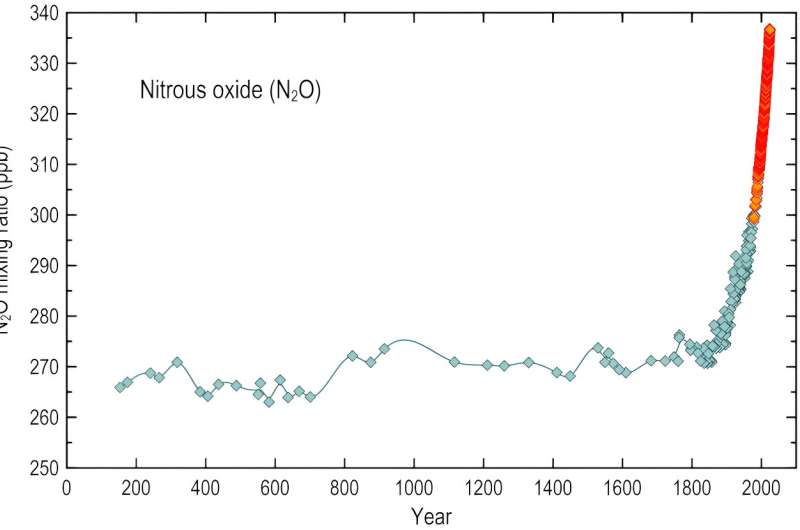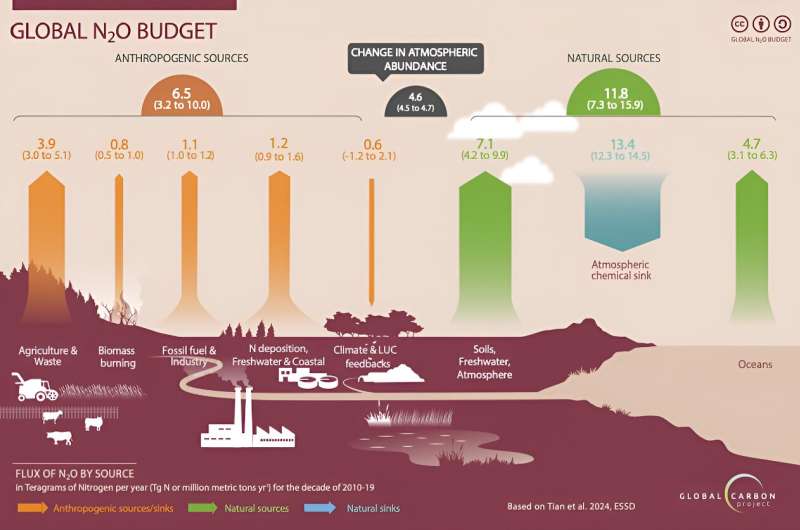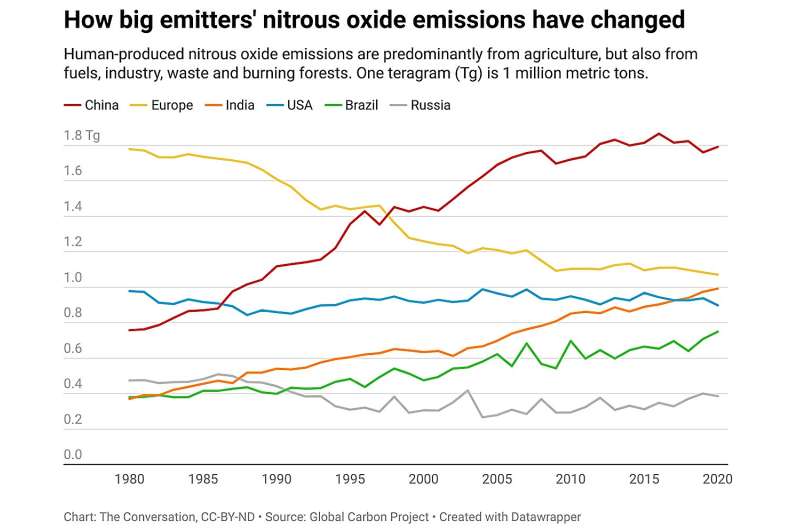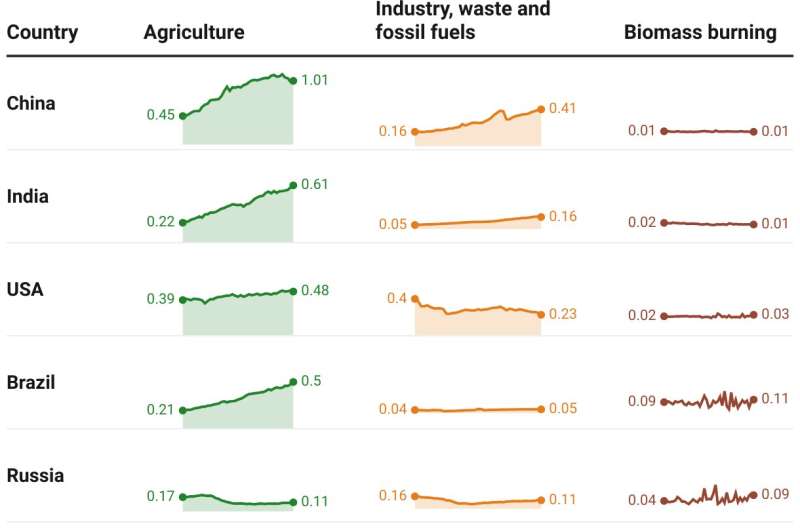This article has been reviewed according to Science X's editorial process and policies. Editors have highlighted the following attributes while ensuring the content's credibility:
fact-checked
trusted source
written by researcher(s)
proofread
Nitrous oxide emissions are accelerating with growing demand for fertilizer and meat

Food's role in climate change has emerged as one of the defining challenges of our time. The journey of a steak, fruit or salad from the vast expanses of agricultural lands to the plates on our tables leaves a significant footprint on the environment.
At the heart of this challenge is the prodigious use of fertilizers and a growing global population's increasing demand for meat.
As Earth, climate and atmospheric scientists, we track global greenhouse gas emissions and have just published the most comprehensive assessment yet of a powerful greenhouse gas from food production: nitrous oxide, or N2O.
After carbon dioxide and methane, N2O is the most consequential greenhouse gas humans are releasing into the atmosphere. While there is less N2O than carbon dioxide in the atmosphere, it is 300 times more powerful at warming the planet, and it remains in the atmosphere, holding in heat, for over a century. Today, atmospheric N2O levels are about 25% higher than before the Industrial Revolution, and they're still rising at an accelerating rate.
We found that globally, fertilizers and the management of livestock manure are leading the increase in N2O emissions and its rapid accumulation in the atmosphere. This is more than a climate problem. N2O also depletes the ozone layer, which protects humans from harmful solar radiation. And nitrogen runoff from fields pollutes waterways, increasing harmful algal blooms and creating oxygen-depleted dead zones.
The growth of N2O emissions is alarming, but people today have the knowledge and many of the technologies needed to reverse the trend.

Where do N2O emissions come from?
Prior to the Industrial Revolution, natural sources of N2O from microbes living in forest soils and in the oceans were roughly equal to natural sinks that consumed N2O in the air, so N2O atmospheric concentrations were relatively constant.
However, the human population and its demand for food have grown rapidly, throwing that natural equilibrium out of whack.
We found that human activities alone have increased N2O emissions by 40% over the past four decades, with agriculture contributing approximately 74% to the total anthropogenic N2O emissions.
The biggest human sources of N2O are agriculture, industry and the burning of forests or agriculture waste.
Nitrogen fertilizers, widely used in agriculture, are one of the biggest contributors. Fertilizers are responsible for 70% of total agricultural N2O emissions globally. Animal manure from intensive animal farming contributes around 30%. A smaller source but one that is rapidly growing is aquaculture, such as fish farming, particularly in China, where it has increased twenty-fivefold in the past 40 years.
In addition to farming, industrial processes such as production of nylon, explosives and fertilizers, and the combustion of fossil fuels also contribute to N2O emissions, but to a lesser extent than agriculture.

N2O emissions by country
Emissions vary greatly country to country for a number of social, economic, agricultural and political reasons.
Emerging economies, such as China and India, have had strong increasing N2O trends over the past four decades as they boosted agricultural productivity to meet their growing populations' food demand.
China is the largest producer and user of chemical fertilizers. Its Action Plan for Zero Growth in Fertilizer Use by 2020, issued in 2015, has helped cut those N2O emissions. However, its industrial N2O emissions have continued to rise.
In Brazil and Indonesia, cutting down and burning forests to make room for crops and livestock, coupled with increasingly intensive farming practices, has exacerbated nitrogen losses from natural sources and amplified greenhouse gas emissions.
Africa has opportunities to increase food production without increasing nitrogen fertilization. However, Northern African countries more than tripled their emissions growth in the past two decades, primarily due to a substantial growth in the livestock population in Africa.
A few regions, however, have been able to curtail some of their N2O emissions with more sustainable practices.
The European Union, Japan and South Korea have all successfully reduced anthropogenic N2O emissions over the past 40 years, although they remain major emitters on a global scale; reductions have largely come from the chemical industry in the 1990s. Their nitrogen use in agriculture has also become more efficient; however, they still have work to do. Their emissions from direct fertilizer and manure application have declined only slightly and have recently leveled out.

In the U.S., agricultural emissions continue to creep up, while industrial emissions have declined slightly, leaving overall emissions rather flat.
How to reduce N2O emissions
Addressing the challenge of reducing N2O emissions requires a combination of policy interventions, technological innovation and individual actions. For example:
- Policies can encourage farmers to adopt nitrogen-efficient practices, optimize fertilizer use and reduce N2O emissions and other forms of nitrogen pollution through a variety of incentive programs.
-
Precision agriculture techniques, including the use of remote sensing and satellite GPS-guided equipment, can help farmers vary the rate of fertilizer applied to optimize nutrient management and minimize nitrogen losses, thereby reducing N2O emissions.
- The development and adoption of nitrogen-efficient fertilizers, such as controlled-release formulations and nitrification inhibitors, also offer promising ways to reduce nitrogen runoff and curb N2O emissions from agricultural soils.
- Similarly, innovations in livestock management, such as dietary supplements and improved waste management practices, can reduce the amount of N2O from cattle.
- Industries, particularly production of nylon and fertilizers, can install existing, affordable technologies to abate nearly all of their N2O emissions. That's an easy win for implementation and the climate. Most of the world has already done so, leaving China and the U.S. responsible for most of the remaining industrial emissions of N2O.
- Consumers can also make plant-based foods a larger fraction of their diets. You don't need to become vegan unless you want to, but reducing the frequency and portion sizes of meat and dairy consumption can be healthy for both you and the environment. Eco-friendly practices like composting food waste and reducing fertilizer use on lawns also help.
Overall, a holistic approach combining policy, technology and individual actions is needed to address N2O emissions and combat climate change. With governments, industries and citizens all working toward a sustainable future, these strategies can help ensure food security and environmental sustainability for future generations.
Provided by The Conversation
This article is republished from The Conversation under a Creative Commons license. Read the original article.![]()


















